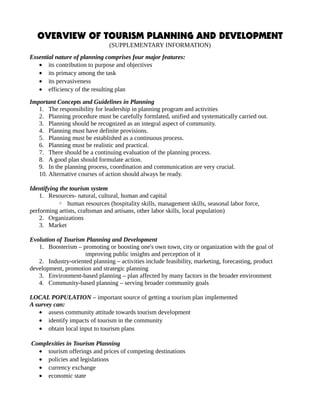CHAPTER 2 supplementary info
•Télécharger en tant que DOC, PDF•
1 j'aime•501 vues
Signaler
Partager
Signaler
Partager

Recommandé
Recommandé
Contenu connexe
Tendances
Tendances (20)
Successful Tourism Strategic Plans for Destinations - Dr. Harsh Varma

Successful Tourism Strategic Plans for Destinations - Dr. Harsh Varma
Similaire à CHAPTER 2 supplementary info
Similaire à CHAPTER 2 supplementary info (20)
Lecture 1. Introduction to Tourism Planning and Development(1).pptx

Lecture 1. Introduction to Tourism Planning and Development(1).pptx
Unit 8: Responsible Tourism Impact Monitoring For Sustainability

Unit 8: Responsible Tourism Impact Monitoring For Sustainability
6 7 8_merencanakan pariwisata berkelanjutan berbasis masyarakat

6 7 8_merencanakan pariwisata berkelanjutan berbasis masyarakat
Community Based Tourism - IDIPT ( HImachal Pradesh) 

Community Based Tourism - IDIPT ( HImachal Pradesh)
Lecture LOCAL DEVELOPMENT by Violeta- Kaunas College

Lecture LOCAL DEVELOPMENT by Violeta- Kaunas College
Regional planning concept in tourism planning.pptx

Regional planning concept in tourism planning.pptx
TOPIC 1.0 INTRODUCTION TO TOURISM PLANNING (1.1 to 1.4) (1).pdf

TOPIC 1.0 INTRODUCTION TO TOURISM PLANNING (1.1 to 1.4) (1).pdf
Mekong tourism sector strategy 2016 2025 - Brainstorming workshop at MTF 2016

Mekong tourism sector strategy 2016 2025 - Brainstorming workshop at MTF 2016
Plus de Reymarie Oohlala
Plus de Reymarie Oohlala (20)
Growth and development of the accommodation business

Growth and development of the accommodation business
CHAPTER 2 supplementary info
- 1. OVERVIEW OF TOURISM PLANNING AND DEVELOPMENT (SUPPLEMENTARY INFORMATION) Essential nature of planning comprises four major features: • its contribution to purpose and objectives • its primacy among the task • its pervasiveness • efficiency of the resulting plan Important Concepts and Guidelines in Planning 1. The responsibility for leadership in planning program and activities 2. Planning procedure must be carefully formlated, unified and systematically carried out. 3. Planning should be recognized as an integral aspect of community. 4. Planning must have definite provisions. 5. Planning must be established as a continuous process. 6. Planning must be realistic and practical. 7. There should be a continuing evaluation of the planning process. 8. A good plan should formulate action. 9. In the planning process, coordination and communication are very crucial. 10. Alternative courses of action should always be ready. Identifying the tourism system 1. Resources- natural, cultural, human and capital ◦ human resources (hospitality skills, management skills, seasonal labor force, performing artists, craftsman and artisans, other labor skills, local population) 2. Organizations 3. Market Evolution of Tourism Planning and Development 1. Boosterism – promoting or boosting one's own town, city or organization with the goal of improving public insights and perception of it 2. Industry-oriented planning – activities include feasibility, marketing, forecasting, product development, promotion and strategic planning 3. Environment-based planning – plan affected by many factors in the broader environment 4. Community-based planning – serving broader community goals LOCAL POPULATION – important source of getting a tourism plan implemented A survey can: • assess community attitude towards tourism development • identify impacts of tourism in the community • obtain local input to tourism plans Complexities in Tourism Planning • tourism offerings and prices of competing destinations • policies and legislations • currency exchange • economic state
- 2. • weather Planning in the International level usually takes place through: • WTO • ICAO • IATA • CTO • PATA • TCSP • SCOT • ASEAN • TCU • SADCC • OECD STAGES OF DESTINATION DEVELOPMENT 1. INCEPTION – discovery 2. GROWTH – local response and initiatives 3. MATURITY – institutionalization 4. DECLINE – saturation and alienation
